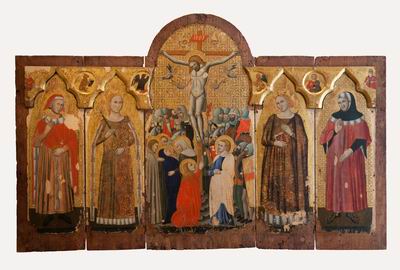
Guida pratica
Artists of the 14th century Rimini School of painting
The 14th century Rimini School is famous for the strong influence received by the great artist Giotto di Bondone, who stopped in Rimini, around 1300, and worked in the church of San Francesco, where he painted a lost cycle of frescoes, while a beautiful 'Crucifix' is still preserved in the apse of the Malatesta Temple, the Cathedral of Rimini.
Here are the artists of the school.
Pietro da Rimini (1280 - 1350)
Painter, born in Rimini. He was one of Giotto's first followers, when the master stopped in the city, and absorbed his new style. The largest number of works of the fourteenth-century Rimini school have been attributed to him. His activity mainly took placey between Romagna and Marche. His paintings, although different in style, show a strong influence of the Giotto's model. They range from the 'Deposition' preserved in the Louvre museum, in the National Museum in Ravenna and in many others. In the area near Rimini, you can admire a 'Crucifix' on display in the church La Collegiata in Santarcangelo di Romagna.
Giovanni da Rimini (c. 1270-1338)
The first document in which is named Giovanni, the main exponent of the great school of painting flourished in Rimini in the fourteenth century, dates back to 1292; it will not be too wrong, therefore, to place his birth around 1270. At the beginning of his career he alternated the profession of artist with that of farmer, as a tenant of a farm in Sant'Ermete.
In the early years of the new century he met and perhaps collaborated with Giotto, who - according to Vasari - stayed and painted in Rimini. In a 1300 paper it is already called "magister", a qualification given to professional painters; in the same document it is specified that his house - and, probably, also his workshop - was located in the district of San Giovanni Evangelista, near the church of Sant'Eufemia.
Recent studies have established that Giovanni had three painter brothers: the older Foscolo and the younger Giuliano and Zangolo. The execution of the famous cycle of frescoes in Sant'Agostino is attributed to Giovanni and his brothers . Only one signed work remains: the Crucifix of Mercatello; for stylistic affinities other works have been attributed to him, including the essential and poetic Crucifix of the Rimini Museums. The last document in which Giovanni is indirectly mentioned is 1338. In that year the date of his death has been located.
Giuliano da Rimini (1307 - 1325 years of activity)
Among the local artists stands out Giuliano da Rimini who was one of the first to incorporate Giotto's style, having acquired his teachings directly in the pictorial yard of San Francesco church in Rimini where Giotto realized the frescoes. We have information of the artist from 1307 to 1324 and his activity developed in parallel with that of Giovanni da Rimini. The City Museum in Rimini preserves the precious polyptych on wood with the coronation of the Virgin, Saints and scenes from the Passion and death of Christ and a fragment depicting a Head of Christ, once belonging to a crucifixion. The master was also active in the surrounding area where frescoes and paintings can be discovered.
Neri da Rimini (1300 - 1322 years of activity)
Born in Rimini, in Santa Cristina, he was a miniaturist and painter from 1300 to 1322, protagonist of the Gothic miniature in Italy. It was influenced by the 14th century Rimini school.
To his artistic works he impressed the naturalness of the poses and the essential composition of Giotto's style. The series of signed works can be found in Faenza, in the Antiphonary of the Duomo, in Bologna in the Civic Museum and in the Vatican Library, the commentary on the Gospels.
Giovanni Baronzio (first half of the 14th century)
Painter born in Rimini, exponent of the 14th century Rimini school, under the influence of Giotto. The traces left by his works, of which only one is signed, are found in the Polyptych 'The Madonna and Child with Two Angels and Saint Francis' and the most important one in the 'Stories from the life of Christ', dated 1340 which is located in the National Gallery in Urbino. Experts attribute to him frescoes in various places in the national territory, where his hand, his sets and his poetics of the figures are recognizable.

©2016-2023 Assessorato al turismo / Comune di Rimini, Piazzale Fellini 3 47921 - Rimini - +39 0541 704587 / Ufficio Informazioni Turistiche (IAT) +39 0541 53399 / fax +39 0541 56598 / Statistiche web


